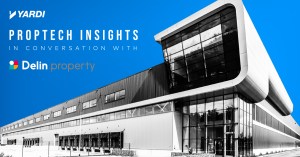By Joel Nelson on August 2, 2020 in Global
The traditional image of a warehouse is that of a windowless box with little visual appeal, inside or out. That perception is giving way to new designs that use technology to integrate efficiency with safety and opportunities for constructive workforce interaction. Delin Property, the leading pan-European real estate investment developer in the logistics market, is on the leading edge of that transformation.
Delin’s status as both a logistics real estate developer, asset manager and investor provided a vantage point for envisioning a new type of storage facility. “We’ve always tried to be on the forefront of design and technology, and to use that motivation to create a better experience for owners, tenants and investors,” says Bart De Sitter, development director for Delin Property’s operations in the Netherlands.
Elevating the human element
Delin Property began its redesign initiative by recognising that labour costs are a warehouse’s largest operational expense. That made improving the experience for both blue- and white-collar workers the company’s top priority.
“A grey box with no windows isn’t sufficient today. You have to create a pleasant workplace to attract and retain the 1,000 to 1,500 workers who staff a warehouse, many of them millennials who have higher expectations of workplace amenities than previous generations,” says Jay Lelie, asset and leasing manager in the Netherlands.
A design along these lines incorporates features such as windows, green spaces and terraces for breaks and meals. “Windows really make a difference when you’re in there for eight hours – not just to let natural light inside but to let workers see outside. Our clients tell us this feature really helps reduce absenteeism, illness and turnover,” according to Lelie.
Along with creating an aesthetically desirable space, Delin Property’s new approach to warehouse design sought to end the sector’s historical workplace separation of white collar and blue-collar workers. “As interactions between managers and their workers become more complex in the e-commerce environment, working closely together onsite becomes more important. We wanted to create an environment that puts a premium on natural interaction and ends separate entrances and canteens and other arbitrary physical or mental barriers,” De Sitter says – although, of course, this scenario can’t be fully realised as long as COVID-19 remains untamed.
Delin Property also put a premium on safety, plotting car and delivery truck routes well away from pedestrian traffic. Other challenges in the redesign included maximising parking spaces in tightly constricted urban locations.
Using tech to strengthen client bonds
Back when Delin Property was solely a property investor, it outsourced most of its direct contact with clients. “That was a logical choice at the time, but it ended up making us too remote from tenants and created too many steps between us and them,’ De Sitter said. “We wanted to manage the communication stream in a way that lets us focus on our relationship with clients rather than on administrative tasks and compiling reports.”
Toward that end, the company has adopted advanced real estate management software solutions from Yardi that enable execution of multiple business operations from a single connected platform and promote staff efficiency and client service.
Delin Property’s invoice processing, for example, will be paperless for tenants and driven by automated workflows all the way to vendor payment. Similarly, automated project management will help keep the company’s construction projects on time and on budget by providing real-time views of data across multiple capital projects. Meanwhile, tenants will have the convenience of making payments, communicating with Delin Property, accessing documents and submitting maintenance requests online or with a remote device. Other solutions will automate preventive maintenance and other elements of facility management while housing records for equipment and maintenance in one database.
A vision rooted in simple changes
All of these design and technology elements combine, according to De Sitter and Lelie, to create a future vision that encompasses “a high-end office with a facility behind it that everybody involved in is proud of and which meets what the market is looking for,” a far cry from warehouses’ nondescript legacy.
They add, “And for all its positive impact on employee motivation, satisfaction and safety, we see the new design concept as a series of fairly simple changes that aren’t that expensive. We think we’ve found a way to future-proof our portfolio and move the industry forward.”


